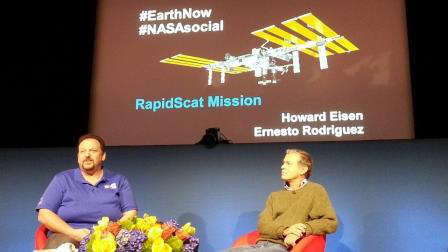Restraints Bring Positive Results
The RapidScat measures the ocean's winds, including directions and speed. An earlier scatterometer, the QuikScat, was sent up to orbit Earth in 1999. It had been measuring Earth's winds until 2009 when it unfortunately shut down. Fast forward a few years to 2012, when Space Station Program Manager, Michael Suffredini, offered JPL a mounting location on the International Space Station (ISS) and a free ride on a SpaceX Dragon cargo mission in 2014. Less than two years to plan and execute an entire mission is far from normal. The typical NASA mission can take a decade to bring to fruition. Having such a short time frame proved to be a positive innovation restraint.
Howard Eisen and Ernesto Rodriguez share with NASA Social attendees about the RapidScat Mission.
Reuse: Parts and Ideas
Rather than designing new hardware, the team chose to review the leftover parts from the QuikScat mission. Much of the equipment had not been dusted off or tested in well over a decade. Fortunately, the parts proved to be ready for the mission even though they'd spent so long on the shelf. These related parts are similar to ideas that are a result of ideation campaigns within a company. In a recent post, Steve Rogers specifically discusses the reuse of concepts and even the connectedness between ideas to build upon each other eventually increasing their potential value. In both cases, the opportunity of utilizing spare parts and ideas often allows for significant savings, in time, money, and technology.
Managed Risk
JPL did need to create new hardware interfaces for the Dragon spacecraft and the ISS. They chose to use off-the-shelf, commercially-available computer hardware rather than the usual hardened-against-radiation computer chips. With this managed risk, if there's an error they simply need to reset the computer. Could a managed risk be helpful in your innovation process?
Ask For the Impossible
One aspect that JPL did need to retrofit was the special connectors that will physically attach the RapidScat to the ISS. They are specially made connectors that the manufacturer hasn't made in years. Although a challenge, JPL convinced the company to make a small run in time for the mission. Sometimes it's worth it to ask for the impossible so that your next big product can manifest.Do More With Less
NASA went from potential expenses of about $400 million for a new, free-flying scatterometer satellite mission to the RapidScat's bargain basement price tag of only $26 million by simply reusing the work they had already done. How often does your company reuse the ideas and innovation research your teams have already done?
Read more about visiting NASA JPL:
NASA Jet Propulsion Laboratory or Bust!
NASA Jet Propulsion Laboratory's Recent Earth Now Event
Additional Sources:
NASA Builds RapidScat Mission with Spare Parts and Short Time






